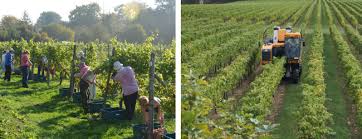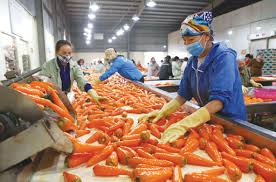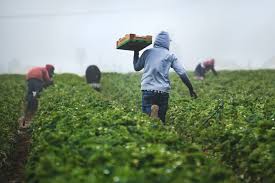Post-harvest handling refers to the process of managing crops after they have been harvested to maintain their quality and extend their shelf life. This crucial stage involves a series of steps designed to minimize losses and preserve the nutritional value of agricultural products before they reach consumers. Proper post-harvest handling is essential for farmers to ensure their crops remain marketable and safe for consumption.
Importance of Proper Post-Harvest Practices
Proper post-harvest practices are important because they significantly affect the quality, safety, and profitability of agricultural produce. By following appropriate techniques, farmers can reduce spoilage, maintain the appearance and taste of crops, and increase their market value.
1. Reducing Losses: Up to 30% of agricultural produce can be lost due to improper handling, transport, and storage. Effective post-harvest practices help minimize these losses.
2. Maintaining Quality: Proper handling ensures that the physical, nutritional, and sensory qualities of the crops are preserved, leading to higher consumer satisfaction.
3. Extending Shelf Life: Good storage and handling practices help slow down spoilage and decay, allowing crops to be stored for longer periods without compromising quality.
4. Food Safety: Proper post-harvest handling ensures that crops remain free from contamination, which is essential for food safety and public health.
Harvesting Techniques and Timing

Harvesting at the right time and using the correct techniques are critical to ensure the quality of the produce is maintained. The ideal time to harvest depends on the type of crop and its purpose (e.g., fresh consumption or processing).
1. Timing: Crops should be harvested when they have reached optimal maturity. Overripe or underripe produce can lose quality and nutritional value. For example, fruits picked too early may not develop the full flavor, while those harvested too late may spoil quickly.
2. Harvesting Methods: Depending on the crop, harvesting can be done manually or mechanically. Manual harvesting involves handpicking, which is commonly used for delicate crops like fruits and vegetables. Mechanical harvesting is more efficient for large-scale crops like grains and legumes, but care must be taken to avoid damaging the produce.
3. Tools: Use appropriate tools such as sickles, knives, or harvesters to minimize damage to the produce. Keeping tools clean and sharp helps prevent bruising and contamination.
Post-Harvest Storage Methods
Proper storage is essential to maintain the quality and prevent spoilage of harvested crops. Different crops require specific storage methods to ensure freshness and extend shelf life.
1. Cold Storage: This method is widely used for perishable products like fruits, vegetables, and dairy items. Cold temperatures slow down the respiration and ripening processes, reducing spoilage.
2. Controlled Atmosphere Storage (CAS): CAS involves adjusting the levels of oxygen, carbon dioxide, and humidity in the storage environment to slow down decay. This method is ideal for long-term storage of fruits like apples and pears.
3. Drying and Curing: Grains, beans, and root crops like potatoes benefit from drying to reduce moisture content, which helps prevent mold growth and rot. Curing involves exposing crops to warm, dry air to toughen their skin, enhancing storage potential.
4. Silos and Bins: Bulk crops like grains are often stored in silos or bins to protect them from pests, moisture, and extreme weather conditions. Proper ventilation is essential to avoid spoilage due to moisture buildup.
5. Packaging: Packaging protects crops from physical damage and contamination. Proper packaging materials, such as breathable bags for vegetables or vacuum-sealed packs for meat, help preserve the quality of the product.
Read Also: Bird of Paradise Flower (Strelitzia reginae): All You Need To Know About
Processing of Agricultural Products

Processing adds value to agricultural produce and helps transform raw crops into marketable goods. Processing can include simple tasks like cleaning and grading, or more complex operations like milling, drying, or canning.
1. Cleaning and Sorting: After harvest, crops should be cleaned to remove dirt, debris, and contaminants. Sorting involves grading the produce based on size, color, and quality to ensure uniformity in the final product.
2. Drying: Drying reduces moisture content, making crops less prone to spoilage. This method is commonly used for grains, seeds, and herbs. It can be done naturally (sun drying) or using machines (mechanical drying).
3. Milling: Milling is the process of grinding grains, such as wheat or rice, into flour or meal. This step increases the marketability and usability of the product in various food industries.
4. Canning and Freezing: Canning involves sealing produce in airtight containers and heating them to kill microorganisms, extending shelf life. Freezing is another common method, particularly for fruits and vegetables, as it locks in freshness and nutritional value.
5. Fermentation: Fermentation is used to preserve and enhance the flavors of products like dairy, vegetables, and grains. It involves the use of beneficial bacteria or yeast to break down sugars, resulting in products like yogurt, sauerkraut, or sourdough bread.
Quality Control During Processing
Quality control ensures that the final processed product meets safety and quality standards. Maintaining high standards throughout the post-harvest process ensures that crops remain fresh, nutritious, and safe for consumption.
1. Inspection: Regular inspections during processing help identify any defects or potential contamination issues. Inspections are essential for ensuring that only high-quality produce enters the market.
2. Testing: Conducting tests for factors like moisture content, microbial contamination, and chemical residues helps maintain food safety. For example, grains are tested for moisture levels before storage to prevent mold growth.
3. Grading: Grading ensures that products are classified based on quality, size, and appearance. This practice is especially important for products sold in retail markets, as consumers expect uniformity.
4. Temperature Control: Ensuring that crops are processed and stored at the appropriate temperatures is essential to avoid spoilage and maintain freshness. Cold chains are especially important for perishables like dairy, meat, and seafood.
5. Record-Keeping: Keeping detailed records of each step in the post-harvest process helps track quality and identify any potential issues. This is especially important for ensuring traceability in food safety programs.
Read Also: General Management Considerations in Livestock Management
Packaging and Labeling for Market Readiness

Packaging and labeling are crucial steps in preparing agricultural products for the market. They protect the produce, extend its shelf life, and provide important information to consumers.
1. Protection: Proper packaging protects products from physical damage, contamination, and environmental factors like moisture or sunlight. It helps maintain freshness, especially for perishable goods like fruits and vegetables.
2. Extending Shelf Life: Packaging materials such as vacuum-sealed bags, breathable containers, or plastic wraps help preserve the quality and freshness of produce by reducing exposure to air, moisture, and microorganisms.
3. Labeling Requirements: Labels provide essential information such as product name, weight, origin, expiry date, and storage instructions. In many markets, nutritional information, certification details (like organic or fair-trade labels), and barcodes are also required.
4. Marketing Appeal: Attractive and well-designed packaging helps catch consumers’ attention and can influence purchasing decisions. The right design enhances the brand’s identity and can communicate product quality.
Transportation and Logistics Considerations
Transporting agricultural products from farms to markets involves careful planning to prevent damage and spoilage. Efficient logistics are vital to ensuring that fresh products reach their destination in optimal condition.
1. Temperature Control: For perishable items like dairy, meat, and fresh produce, refrigerated transportation (cold chain logistics) is necessary to maintain freshness and prevent spoilage. It ensures that crops remain at the right temperature throughout the journey.
2. Time-Sensitive Delivery: Agricultural products are often time-sensitive, and delays in transportation can lead to significant losses. Efficient logistics and timely deliveries ensure that crops arrive at markets while still fresh.
3. Packaging for Transport: Packaging must be designed to withstand the stresses of transportation, including handling and movement. Sturdy boxes, crates, or pallets prevent damage and bruising to the produce during transit.
4. Route Planning and Logistics: Careful planning of routes helps minimize travel time and reduce fuel costs, ensuring that products reach their destination as quickly and efficiently as possible. In rural areas, ensuring good road access and infrastructure is also critical for smooth transport.
Reducing Post-Harvest Losses
Reducing post-harvest losses is essential for improving food security and increasing farmers’ profits. Post-harvest losses occur when produce is damaged, spoiled, or lost during handling, storage, transportation, or processing.
1. Proper Harvesting Timing: Harvesting crops at the right time of maturity reduces spoilage. Early or late harvesting can lead to losses due to poor quality or over-ripeness.
2. Effective Storage Solutions: Proper storage, such as cold storage or dry warehouses, helps extend the shelf life of produce. Technologies like controlled atmosphere storage (adjusting oxygen and carbon dioxide levels) can also help.
3. Training and Education: Farmers, handlers, and distributors must be trained on best post-harvest practices to minimize losses. Simple techniques like gentle handling, proper packaging, and optimal storage conditions can make a big difference.
4. Improved Infrastructure: Good roads, transport vehicles, and storage facilities are key to reducing losses. Investments in rural infrastructure help ensure that farmers can transport their products to markets efficiently.
Best Practices for Market Distribution
Efficient market distribution ensures that agricultural products reach consumers in the best possible condition. By following best practices, farmers and distributors can improve the flow of goods, maintain product quality, and maximize profits.
1. Building Strong Supply Chains: Collaborating with reliable transporters, distributors, and retailers ensures smooth operations and minimizes bottlenecks in the supply chain. Having a strong network helps prevent delays and losses.
2. Market Forecasting: Anticipating market demand helps farmers produce and distribute the right amount of produce, reducing the risk of overproduction or shortages. Market research and forecasting tools can help with this.
3. Diversifying Markets: Farmers can reduce risks by supplying to multiple markets (local, national, and international). Diversifying market outlets helps protect against price fluctuations or changes in demand in one specific market.
4. Ensuring Consistent Quality: Consistent quality in produce helps build a positive reputation and long-term relationships with buyers and consumers. Grading, sorting, and quality control practices are essential in maintaining consistency.
Economic Impact of Efficient Post-Harvest Handling
Efficient post-harvest handling can have a profound economic impact on farmers, markets, and consumers. It increases profitability, reduces losses, and improves food security.
1. Increased Farmer Income: By minimizing losses and maintaining the quality of their crops, farmers can earn more from their produce. Better packaging, handling, and transportation mean they can sell at higher prices.
2. Reduced Waste: Efficient handling reduces food waste, which is both an economic loss and a waste of resources used in production (water, labor, inputs). Less waste means more food available for sale and consumption.
3. Market Access: High-quality produce with longer shelf life can reach distant or international markets, opening up new economic opportunities for farmers and exporters. This allows for greater participation in global trade.
4. Job Creation: Efficient post-harvest systems, including improved logistics, storage, and processing, create job opportunities across the supply chain—from farmers to transporters, warehouse managers, and processors.
5. Enhanced Food Security: Reducing post-harvest losses means more food is available to feed growing populations, enhancing food security. Improved post-harvest systems make food more accessible and affordable for consumers.
Proper post-harvest handling is a vital part of the agricultural supply chain. By using the right harvesting, storage, and processing techniques, farmers can preserve the quality of their crops, reduce waste, and ensure that consumers receive fresh, safe, and nutritious products.
Maintaining high standards in quality control throughout the process is essential for building trust with consumers and achieving long-term success in the agricultural industry.
Do you have any questions, suggestions, or contributions? If so, please feel free to use the comment box below to share your thoughts. We also encourage you to kindly share this information with others who might benefit from it. Since we can’t reach everyone at once, we truly appreciate your help in spreading the word. Thank you so much for your support and for sharing!
Read Also: What is some advantages of solar energy?
Frequently Asked Questions
We will update this section soon.

